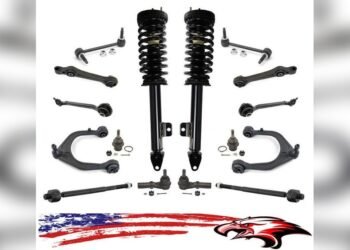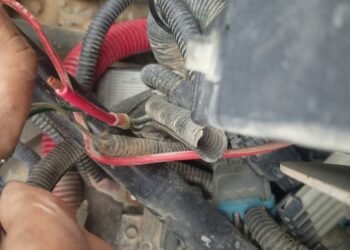Toyota Tacoma transmission problems include slipping, rough shifting, and failure to engage, often due to low or contaminated fluid. Owners may face issues with automatic transmissions, such as the “Tacoma Lurch,” especially at high mileage.
These problems can lead to difficulties in shifting gears properly, impacting the vehicle’s performance and safety. Addressing transmission issues promptly is crucial to prevent further damage and maintain the vehicle’s reliability. Regular maintenance checks and timely fluid replacements can help mitigate these common problems, ensuring a smooth driving experience for Toyota Tacoma owners.
Identifying Tacoma Transmission Issues
Identifying transmission issues in your Toyota Tacoma is crucial to maintaining the longevity and performance of your vehicle. Understanding the symptoms of transmission failure and the unique ‘Tacoma Lurch’ phenomenon can help you address potential issues before they escalate.
Symptoms Of Transmission Failure
Recognizing the signs of transmission failure in your Tacoma is essential for timely intervention. Look out for delayed engagement when shifting gears, unusual noises such as whining or clunking, burning smells indicating overheating, and fluid leaks under the vehicle.
The ‘tacoma Lurch’ Phenomenon
The ‘Tacoma Lurch’ is a notorious issue reported by owners, characterized by a sudden jolt or lurch when the transmission shifts gears, particularly from first to second. This can be alarming and potentially dangerous, necessitating immediate attention from a qualified mechanic.
Common Tacoma Transmission Complications
When it comes to the Toyota Tacoma, transmission issues can be a cause of concern for owners. The transmission is a critical component of any vehicle, and when problems arise, it can lead to a range of complications. Let’s take a closer look at some of the common transmission problems that Tacoma owners may encounter.
Automatic Transmission Slipping
One of the most common issues that Toyota Tacoma owners may face is automatic transmission slipping. This occurs when the transmission fails to maintain a consistent gear, causing the vehicle to unexpectedly shift out of gear. This can lead to a loss of power and control, posing a safety risk for the driver and passengers.
Rough Shifting And Engagement Problems
Another prevalent concern with Tacoma transmissions is rough shifting and engagement problems. This manifests as jerky or delayed gear shifts, making for a less than smooth driving experience. It can also lead to premature wear and tear on the transmission components, potentially resulting in costly repairs down the line.
High-mileage Transmission Woes
High-mileage Toyota Tacoma owners may face transmission problems, such as shifting issues and failure to engage properly. These automatic transmission woes can be attributed to wear and tear over time, potentially requiring a replacement for smoother performance.
High-Mileage Transmission Woes If you’re a proud owner of a Toyota Tacoma, you know that it’s a reliable truck with impressive off-road capabilities. However, like any vehicle, it’s not immune to problems. One of the most common issues that Tacoma owners face is transmission problems, especially as the truck gets older and accumulates more miles. In this post, we’ll discuss the high-mileage transmission woes that many Tacoma owners face and what you can do to prevent them. Durability Beyond Certain Mileage Tacoma owners have reported experiencing automatic transmission problems once their vehicle has reached a certain high-mileage point. The transmission may not shift properly, which can lead to a jerky ride or even cause the transmission to slip. This is a frustrating problem for any driver, but it’s especially concerning for those who rely on their Tacoma for work or off-road adventures. Preventive Measures for Longevity Fortunately, there are some preventative measures you can take to extend the life of your Tacoma’s transmission. First and foremost, it’s important to keep up with routine maintenance, including regular transmission fluid changes. Dirty or low transmission fluid can cause a host of problems, including transmission slipping and shifting issues. You should also avoid overloading your Tacoma, as this can put extra strain on the transmission and cause it to wear out faster. Another way to prevent transmission problems is to invest in a quality torque converter. The torque converter helps to transfer power from the engine to the transmission, and a high-quality converter can help to reduce wear and tear on the transmission over time. Finally, if you do experience any transmission problems, it’s important to address them promptly. Ignoring transmission issues can cause further damage and lead to costly repairs down the line. In conclusion, if you own a Toyota Tacoma, it’s important to be aware of the potential transmission problems that can arise as your truck gets older. By taking preventative measures and addressing any issues promptly, you can extend the life of your transmission and keep your Tacoma running smoothly for years to come.Diy Transmission Fluid Check
Checking the transmission fluid in your Toyota Tacoma is a crucial part of vehicle maintenance. It’s a simple process that can help you detect potential problems early on and prevent costly repairs down the road. In this guide, we will walk you through the DIY transmission fluid check, covering how to locate and read the dipstick, as well as assessing fluid levels and quality.
How To Locate And Read The Dipstick
Start by ensuring that your vehicle is on level ground and the engine is running. Locate the transmission fluid dipstick, which is typically labeled and positioned towards the back of the engine bay. Pull the dipstick out and wipe it clean with a lint-free cloth or paper towel.
Assessing Fluid Levels And Quality
After wiping the dipstick, reinsert it completely and then pull it out again. Check the fluid level, which should fall within the designated “hot” or “cold” range, depending on whether the engine is warm or cold. Additionally, inspect the color and consistency of the fluid. Healthy transmission fluid should be clear and reddish, with no burnt odor or discoloration.
Fluid Change Challenges
Fluid change challenges are a common concern for Toyota Tacoma owners, particularly when it comes to understanding sealed transmissions and the possibility of self-service fluid changes. Let’s delve into these topics to shed light on the complexities of maintaining a healthy transmission.
Understanding Sealed Transmissions
Toyota Tacomas are equipped with sealed transmissions, which means the fluid is not intended to be routinely changed or serviced. The design of these transmissions aims to minimize the need for regular maintenance, but it also presents challenges when it comes to performing fluid changes.
Is A Self-service Fluid Change Possible?
Many Tacoma owners wonder if they can change the transmission fluid themselves. While it is technically possible, it involves overcoming several hurdles. Firstly, accessing the sealed transmission pan and ensuring a complete fluid drain can be quite challenging. Additionally, obtaining the specific type of transmission fluid recommended for Tacomas and refilling the transmission to the correct level require precision and expertise.
Transmission Temperature Troubleshooting
Troubleshooting transmission temperature in Toyota Tacoma can help address potential transmission issues. Monitoring temperature levels and ensuring proper maintenance can prevent costly repairs. Regular checks and timely action can prolong the lifespan of your Tacoma’s transmission.
Transmission Temperature Troubleshooting One of the most common Toyota Tacoma transmission problems is overheating. Overheating can lead to poor performance and damage to the transmission. Therefore, it is important to troubleshoot transmission temperature issues to avoid costly repairs. In this section, we will discuss methods to monitor temperature and the impact of overheating on performance. Methods to Monitor Temperature To monitor the transmission temperature, you can use a temperature gauge, a scan tool, or an infrared thermometer. The temperature gauge is the easiest and cheapest method. However, it only gives you a rough idea of the temperature. The scan tool is more accurate and gives you real-time data. The infrared thermometer is the most accurate method, but it requires some expertise to use. Impact of Overheating on Performance Overheating can cause a range of problems in your Toyota Tacoma. It can damage the internal components of the transmission and lead to poor performance. The transmission fluid can break down and lose its ability to lubricate the transmission. This can cause the gears to grind and the transmission to slip. In severe cases, the transmission can fail completely. To avoid these problems, you should monitor the transmission temperature regularly and take action if it exceeds the normal range. You should also change the transmission fluid according to the manufacturer’s recommendations. This will ensure that the transmission is properly lubricated and cooled. In conclusion, monitoring the transmission temperature is an important part of troubleshooting Toyota Tacoma transmission problems. By using the right tools and techniques, you can prevent overheating and avoid costly repairs.Quick Fixes For Tacoma Owners
Dealing with transmission problems in your Toyota Tacoma can be frustrating, but there are some quick fixes that may provide temporary relief while you figure out the best course of action. Here are some practical solutions to address common transmission issues in your Tacoma.
Temporary Solutions For Immediate Relief
- Check Transmission Fluid: Ensure that the transmission fluid level is adequate and that it is not burnt or contaminated. Low or dirty transmission fluid can cause shifting problems.
- Reset the ECU: Disconnect the battery for a few minutes to reset the electronic control unit (ECU). This can sometimes resolve minor transmission issues.
- Inspect Transmission Mounts: Worn or damaged transmission mounts can lead to excessive vibration and erratic shifting. Inspect and replace if necessary.
- Address Electrical Issues: Check for any loose or corroded electrical connections that may be affecting the transmission’s performance.
When To Opt For Professional Repair
If these temporary fixes do not resolve the transmission issues in your Tacoma, it may be time to seek professional repair. Continuing to drive with unresolved transmission problems can lead to further damage and costly repairs down the line. Be sure to consult a qualified mechanic or dealership to diagnose and address the root cause of the transmission issues.

Credit: www.fs1inc.com
Cost Considerations For Repairs
When it comes to Toyota Tacoma transmission problems, one crucial factor that cannot be overlooked is the cost considerations for repairs. Addressing transmission issues can be a significant financial burden, and understanding the potential expenses involved is essential for Tacoma owners.
Transmission Replacement Expenses
Replacing a transmission in a Toyota Tacoma can be a substantial investment. On average, the cost of a transmission replacement for a Tacoma ranges from $2,800 to $3,400. However, this cost can vary based on factors such as the model year of the Tacoma, the extent of the damage, and the labor rates at the repair facility.
Budgeting For Tacoma Maintenance
Given the potential expenses associated with transmission repairs, it is crucial for Tacoma owners to budget for ongoing maintenance. Regular transmission fluid checks and servicing can help prevent major transmission problems and reduce the likelihood of costly repairs. By allocating funds for routine maintenance, Tacoma owners can mitigate the risk of encountering transmission issues and minimize the financial impact of unexpected repairs.
Prevalence Of Issues By Model Year
The prevalence of Toyota Tacoma transmission problems can vary by model year, leading to frustrations for owners dealing with these issues. Understanding which Tacoma models are more prone to transmission problems can help potential buyers make informed decisions.
Tacoma Models Prone To Transmission Problems
Identifying the specific Tacoma models that are more susceptible to transmission issues can shed light on potential problem areas. By knowing which models have a history of transmission problems, owners can be proactive in addressing any potential issues.
Recalls And Manufacturer Acknowledgments
Recalls and manufacturer acknowledgments play a crucial role in addressing transmission problems in Toyota Tacoma vehicles. Keeping abreast of any recalls or acknowledgments from the manufacturer can help owners stay informed and take necessary actions to rectify transmission issues.

Credit: gtautomotive.com
Addressing The Transmission Pan And Fluid
Ensuring the health of your Toyota Tacoma’s transmission involves paying close attention to the transmission pan and fluid. Regular inspection and maintenance of these components can help prevent costly transmission problems down the line.
Steps For Pan Inspection
- 1. Locate the transmission pan underneath the vehicle.
- 2. Remove the bolts securing the pan in place.
- 3. Inspect the pan for any signs of damage, such as cracks or leaks.
- 4. Clean the pan thoroughly to remove any debris or contaminants.
- 5. Replace the pan gasket if necessary to ensure a proper seal.
Transmission Fluid Quality And Replacement
- Check the transmission fluid level using the dipstick.
- Inspect the color and consistency of the fluid.
- If the fluid is dark or has a burnt smell, it may indicate a problem.
- Consider flushing the old fluid and replacing it with fresh, high-quality transmission fluid.
Electronic Factors Affecting Transmission
Electronic factors play a crucial role in Toyota Tacoma transmission problems. Issues such as slipping, rough shifting, and failure to engage may be attributed to electronic malfunctions within the transmission system. These problems often require thorough diagnosis and potential replacement to ensure smooth vehicle operation.
Role Of Electronics In Transmission Function
Electronic components play a crucial role in the proper functioning of a vehicle’s transmission system. The transmission control module, sensors, and solenoids work together to ensure smooth gear shifts and optimal performance.
Troubleshooting Electronic Transmission Issues
When dealing with electronic transmission problems in a Toyota Tacoma, it is essential to diagnose and address the root cause effectively. Common electronic issues include faulty sensors, wiring problems, or malfunctioning control modules.
Long-term Reliability And Monitoring
The long-term reliability and monitoring of Toyota Tacoma transmission problems are crucial for ensuring smooth performance. Regular monitoring helps in detecting any potential issues such as slipping, rough shifting, or failure to engage, allowing for timely maintenance and preventing major transmission problems down the line.
Regular monitoring of the transmission system is essential to maintain the vehicle’s performance and longevity.
Sustaining Performance Over Time
Long-term reliability and monitoring of your Toyota Tacoma’s transmission are crucial to ensure sustained performance over time. Keeping a close eye on the transmission system can help prevent potential issues from escalating and impacting the overall functionality of your vehicle.
Regular Check-ups And Maintenance Tips
Regular check-ups and maintenance play a vital role in the longevity of your Toyota Tacoma’s transmission. By following these maintenance tips, you can help ensure the smooth operation of your vehicle:
- Schedule routine transmission inspections to detect any early signs of wear or damage.
- Monitor transmission fluid levels and quality regularly to prevent overheating and friction.
- Follow the manufacturer’s recommended maintenance schedule for transmission servicing.
- Address any unusual noises or vibrations promptly to avoid potential transmission problems.

Credit: m.youtube.com
Frequently Asked Questions
What Is A Common Problem With Toyota Tacoma?
One common problem with Toyota Tacoma is transmission issues. Some drivers have reported slipping, rough shifting, failure to engage, and faulty automatic transmission once the car reaches a certain high-mileage point. Low or contaminated transmission fluid can also cause transmission problems.
It should be covered under warranty, but it’s still frustrating for drivers.
How Much Does It Cost To Replace A Transmission In A Toyota Tacoma?
The cost to replace a transmission in a Toyota Tacoma ranges from $1,800 to $3,400.
What Year Toyota Has Transmission Problems?
Toyota Tacoma had transmission problems in various model years, leading to issues like slipping, rough shifting, and failure to engage.
Do Tacomas Have Transmission Problems?
Some Toyota Tacoma drivers have reported experiencing transmission problems, including slipping, rough shifting, and failure to engage, especially once the vehicle reaches a certain high-mileage point. However, not all Tacoma models have transmission issues, and regular maintenance can help prevent them.
What Are The Common Toyota Tacoma Transmission Issues?
Toyota Tacoma drivers may face shifting problems, rough shifting, and transmission failure.
Conclusion
Addressing Toyota Tacoma transmission problems promptly is crucial for vehicle longevity and safety. Regular maintenance and early detection can prevent costly repairs down the line. Stay informed, stay proactive, and enjoy a smooth driving experience in your Toyota Tacoma.
















